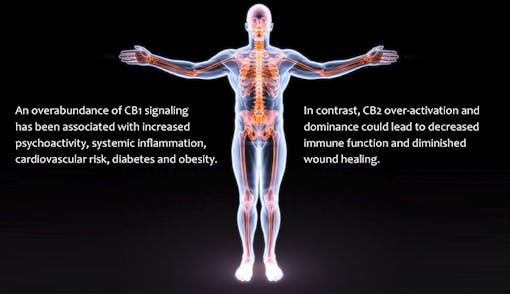https://www.leafly.com/strains/lists/condition/depressionThis article is sponsored by PlusCBD Oil, a product line from CV Sciences (formerly CannaVest). CV Sciences is one of the leading suppliers and manufacturers of agricultural hemp-derived CBD bulk and finished products.
Many of us realize the important of “balance” in our daily lives. Balancing work and play is a critical part of our physical and mental health. Nutritional scientists have shown that balancing omega-6 fats (which are generally, but not always, pro-inflammatory and therefore considered the “bad guys”) with omega-3 fats (the “good guys”) can impact a multitude of health outcomes. For example, replacing omega-6 rich processed foods (e.g., french fries, potato chips, and pastries) with omega-3 rich healthy alternatives (e.g., salmon steak, sardines, and fresh leafy vegetables) improves cardiovascular health, brain health, and metabolic wellness. A similar analogy can be used when discussing endocannabinoids and endocannabinoid “tone/balance.”
What Is the Endocannabinoid System?

To briefly review, the endocannabinoid system is a group of specialized lipids, their receptors, and the enzymes that produce and degrade them. Through direct and indirect actions, endocannabinoids are known to modulate and influence a variety of physiological systems, including appetite, pain, inflammation, thermoregulation, intra-ocular pressure, sensation, muscle control, energy balance, metabolism, sleep health, stress responses, motivation/reward, mood, and memory.
What Are Cannabinoid Receptors?

Cannabinoid receptors are an important class of cell membrane receptors that are also known to have a serpentine shape. Receptors are akin to “locks,” and the ligand compounds that bind to them are akin to “keys” in a lock & key system. They have about seven sections that pass through the outer cell membrane. Cannabinoid receptors are also coupled to G-proteins, where a lot of the signaling “magic” happens when a molecule or compound binds to the outer portion of these receptors. The three main ligands that bind to cannabinoid receptors are all lipophilic (fatty or “fat-loving” compounds), and include endocannabinoids (synthesized within the body), phytocannabinoids (plant-derived, such as from cannabis), and synthetic cannabinoids.
The cannabinoid receptors are further divided into two main subtypes, known as CB1 and CB2. Although they have some similarity, they are mostly differentiated by what tissue or organ system they are associated with in the body. CB1 is found mostly in the brain, with some presence in lung, kidney, liver, fat, heart, muscle, and bone. CB1 receptors are mostly associated with the psychoactive and euphoric aspects of THC. However, CB2 receptors are mostly found within the immune system and blood cells, and secondarily in lesser density within the nervous system, liver, gut, muscle, and bone.
How Do Cannabinoid Receptors Contribute to the Balance of the Endocannabinoid System?

Endocannabinoid tone/balance is the relative contributions of CB1 vs. CB2 activity at any given time. Research is accumulating that shows CB1 dominance is associated with increased perception of stress, anxiety, paranoia, augmented appetite, and decreased nausea/vomiting and pain, as well as enhanced immune surveillance, the latter of which has been demonstrated in certain cancer models. In contrast, CB2 dominance is associated with decreased inflammation and tissue injury, in conjunction with improvements in metabolic health, insulin signaling/sensitivity, satiety, and energy balance.
Using this information, some scientists are zeroing in on specific CB1 blockers that could improve many of the symptoms of metabolic syndrome. Metabolic syndrome is a cluster of risk factors that increase the risk of heart disease, stroke, and diabetes. Specifically, it includes increased blood pressure, high blood sugar, excess body fat around the waist, and abnormal cholesterol levels. Some research in this area has already demonstrated that peripheral CB1 inhibition reduces blood pressure and blood sugar and improves cholesterol levels, as well as leads to visceral fat loss resulting in a lower risk for cardiovascular disease and type II diabetes.
What Does a Balanced Endocannabinoid System Look Like?

Recent biochemical and behavioral findings demonstrate that “optimal” activation of CB1 receptors promotes antidepressant-like neurochemical changes and behavioral effects consistent with antidepressant/anti-stress activity in rodents. These findings reinforce the importance of a balanced endocannabinoid system.
The endocannabinoid system is known to control the proliferation, differentiation, survival, and immune competence of the often-neglected integumentary organ system (i.e., skin cells and hair). Targeting and manipulating endocannabinoid balance with the intent to normalize unwanted skin cell growth and skin inflammation might be beneficial for a variety of human skin conditions (psoriasis, eczema, acne, dermatitis, systemic sclerosis, etc).
Our initial example drawing comparisons between the omega-6: omega-3 essential polyunsaturated fatty acid (PUFA) balance and the CB1: CB2 endocannabinoid tone is even more appropriate as dietary PUFA intake has been shown to influence the levels of anandamide and 2-AG (the two most prominent endocannabinoids in humans). Therefore, the balance of omega-6 and omega-3 PUFA is an important modifier for the activation and suppression of cannabinoid signaling in cells.
To illustrate this point, Hutchins-Weise et al. published findings from a rodent model of immobilization-disuse atrophy in combination with fish oil supplementation. The increased omega-3 levels from fish oil consumption caused significant changes in the endocannabinoid system (increased receptors of CB2, but decreased levels of 2-AG and CB1 activity) of the mice by sensitizing the muscle to counter the effects of immobilization and hind-limb suspension.
What Happens When the Endocannabinoid System Becomes Imbalanced?

Keep in mind that “balance” is critical, as research has shown if we tip the scales too heavily in the direction of CB1 inhibition, there may be an associated decrease in fertility, with increased risk of depression, mood disturbance, and immunosuppression. An overabundance of CB1 signaling has been associated with increased psychoactivity, systemic inflammation, cardiovascular risk, diabetes, and obesity. In contrast, CB2 over-activation and dominance could lead to decreased immune function and diminished wound healing.
References:
Castillo PE, et al. Endocannabinoid Signaling and Synaptic Function. Neuron. 2012. 76(1):70-81
Bíró T, Tóth BI, Haskó G, Paus R, Pacher P. The endocannabinoid system of the skin in health and disease: novel perspectives and therapeutic opportunities. Trends in Pharmacological Sciences. 2009;30(8):411-420. doi:10.1016/j.tips.2009.05.004.
Witkin JM, Tzavara ET, Nomikos GG. A role for cannabinoid CB1 receptors in mood and anxiety disorders. Behavioural Pharmacology. 2005;16(5-6):315-331. doi:10.1097/00008877-200509000-00005.
Hutchins-Wiese HL, Li Y, Hannon K, Watkins BA. Hind limb suspension and long-chain omega-3 PUFA increase mRNA endocannabinoid system levels in skeletal muscle. J Nutr Biochem. 2012 Aug;23(8):986-93.






